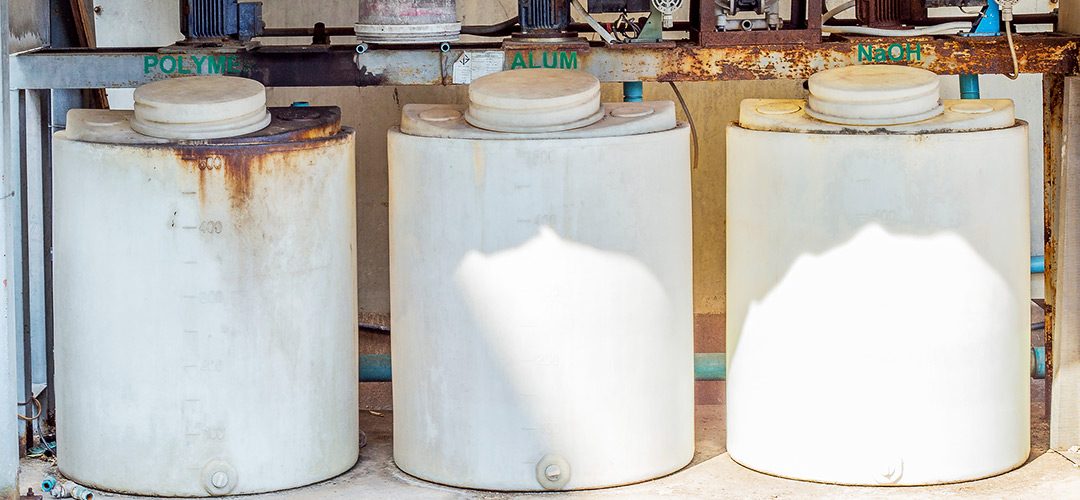Improve Phosphorus Removal And Simplify
If you are using ferric or aluminum-based coagulants to remove phosphorus from your effluent, there’s good news. One easy switch can significantly improve your phosphorus removal and simplify your operation. You can probably make the switch using equipment you already have.
Lower Doses Mean Fewer Chemical Deliveries, Smaller Tanks, Smaller Pumps, And Less Hassle
By switching to rare earth elements, like the cerium and lanthanum found in Neo WaterFX300 (formerly RE300), plants can drastically reduce the volume of phosphorus removal chemical needed. Whereas iron- or aluminum-based coagulants require a 4 to 1 molar ratio of Fe or Al to P, or even more, to achieve levels of effluent levels of 1 mg/l or less, Neo WaterFX300 (formerly RE300) can achieve very low phosphorus limits with a 1:1 molar ratio of RE:P. How much difference can this make? A 0.5 million gallon/day (MGD) membrane bioreactor (MBR) plant which required 150 to 200 gallons/day (gpd) of alum now needs only 20 gpd of Neo WaterFX300 (formerly RE300) to hit a 0.08 mg/l phosphorus level. A 2 MGD plant in New Jersey switched from using 120 gpd of alum to 17 to 20 gpd of Neo WaterFX300 (formerly RE300) to achieve a 0.76 mg/l phosphorus limit.
Reductions In Dewatering Polymer, Lime And Caustic
In many cases, switching to Neo WaterFX300 (formerly RE300) will help you reduce or eliminate other chemicals as well. Because the rare earth elements bind tightly to the phosphorus, and have a high molecular weight, they settle well, trapping less bound water. In the process of settling, the solids collect the particulate non-reactive phosphorus, causing it to settle with it. The result is a denser sludge that requires little to no polymer for optimal dewatering. In addition, Neo WaterFX300 (formerly RE300) is much less acidic, with a pH of 3-4, as opposed to either ferric or alum coagulants, which often have a pH of 1.5 to 2.3. And because you use MUCH less, it impacts the pH much less. By maintaining more of the wastewater’s natural alkalinity, nitrification can proceed without additional lime and the final effluent typically does not require caustic for pH adjustment to discharge limits.
You Have What You Need For The Switch
Odds are you already have all the equipment you need on site. Just a modest size HDPE or FRP tank, a standard chemical metering pump and some tubing, and you are set. Because Neo WaterFX300 (formerly RE300) never degrades, you could use the former ferric or alum tank and go months between chemical deliveries instead of only weeks.
Choose Your Dosing Point, Then Plug And Play
Before the primary clarifier, at the aeration basin, at the secondary clarifier, or prior to final polishing filtration, you can feed Neo WaterFX300 (formerly RE300) at the point or points for maximum effectiveness for your plant. The small equipment footprint allows for quick setup and maximum flexibility.
With ferric and alum, mixing is critical to efficient chemical use. Scaling up to full plant implementation based on jar test dosages frequently requires increasing the dose significantly to account for the imperfect mixing of the actual plant. But because the Neo WaterFX300 (formerly RE300) tightly binds the P in a dense crystalline solid, your jar test will accurately reflect the dosage and results you can expect in your plant. No surprises, no disappointment.
Let Us Demonstrate With A Pilot
With a tote, a catch basin and a metering pump, we can come to your plant and demonstrate the benefits of using Neo WaterFX300 (formerly RE300) on your wastewater. Take the guesswork out of meeting your phosphorus limit. Try out different feed points. Experience the Neo WaterFX300 (formerly RE300) difference with fewer chemical deliveries, sludge reduction, ease of operation, improved dewatering, reduced disposal costs, and reduced maintenance.
Phosphorus reduction just got easier. Contact us today.
Signup for occasional email updates at https://neowatertreatment.com/contact/get-updates/.



